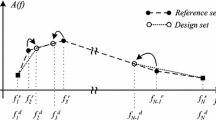Abstract
A modified model, in the form of an FIR filter, is proposed for the modelling of the acoustic dynamics of an active noise control system. This is a low order filter formulation but consists of two independent elements—a time delay and a d.c. gain. Empirical data has shown that this model constitutes a good representation of the equivalent high order FIR filter and has the additional feature of being a high frequency noise filtering device. Because of its specific structure, the time delay and gain must be identified independently. This restricts the use of the conventional least mean squares technique for parameter optimization, as the cost function intrinsically comprises multimodal error surfaces. The use of Genetic Algorithms could be the best solution to address this issue but their unpredictable response in real-time require some special attention. A fully developed active noise control system, based on the Genetic Algorithm, to achieve the objective of noise reduction is described. To further guarantee the reliability of this approach, a supervisory scheme is incorporated for governing the real-time learning operations. A parallel hardware architecture, using two independent TMS320C30 digital signal processors, is designed for such implementation. The experimental results indicate that this approach to noise control is sound, and that noise reduction of more than 15dB(A) is consistently obtained.
Similar content being viewed by others
References
Alander, J. T. 1994. An Indexed Bibliography of Genetic Algorithms: Years 1957–1993. Report No. 94-1. Department of Information Technology and Production Economics, University of Vaasa.
Baek, K. H., and Elliott, S. J. 1993. Natural algorithms for choosing source locations in active cntrol system. Proc. Workshop on Natural Algorithms in Signal Processing, Chelmsford, Essex, pp. 23/1–25/10.
Baker, J. E. 1987. Reducing bias and inefficiency in the selection algorithms. Proc. 2nd Int. Conf. Genetic Algorithms. Lawrence Erlbaum Associates, Hillsdale, pp. 14–21.
Berge, O., Petterson, K. O., and Sorzdal, S. 1988. Active Cancellation of transformer nose: Field measurements. Applied Acoustics 23: 309–320.
Cheuk, K. P., Man, K. F., Ho, Y. C., and Tang, K. S. 1994. Active noise control for power transformer. Proc. 1994 Int. Congress on Noise Control Engineering. Yokohama, Japan, pp. 1365–1368.
Chipperfield, A. J. and Fleming, P. J. 1994. Parallel Genetic Algorithms: A Survey. ACSE Research Report, No. 518. University of Sheffield.
Elliott, S. J., Nelson, P. A., Stothers, I. M., and Boucher, C. C. 1990. In-flight experiments on the active control of propeller-induced cabin noise. J. Sound and Vibration 140: 219–238.
Fonseca, C. M., and Fleming, P. J. 1993. Genetic Algorithms for Multiobjective Optimization: Formulation, Discussion and Generalization. ACSE Research Report No. 466. University of Sheffield.
Fonseca, C. M., and Fleming, P. J. 1994. An Overview of Evolutionary Algorithms in Multiobjective Optimization. ACSE Research Report No. 527. University of Sheffield.
Goldberg, D. E. 1989. Genetic Algorithm in Search, Optimization, and Machine Learning. Addison Wesley Publishing Company.
Goldberg, D. E. 1994. Genetic and evolutionary algorithms come of age. Communications of the ACM 37(3): 113–119.
Hall, H. R., Ferren, W. B., and Bernhard, R. J. 1992. Active control of radiated sound from ducts. Trans. of the ASME 114:338–346.
Holland, H. 1975. Adaptation in Natural and Artificial Systems. Ann Arbor: The University of Michigan Press.
Kido, K., Abe, M., and Kanai, H. 1989. A new arrangement of additional sound source in an active noise control system. Proc. Inter-Noise 89, pp. 483–488.
Mackle, G., Savic, D. A., and Walters, G. A. 1995. Application of genetic algorithms to pump scheduling for water supply. Proc. Genetic Algorithms in Engineering Systems: Innovations and Applications pp. 400–405.
Michalewicz, Z. 1994. Genetic Algorithms + Data Structures=Evolution Programs. 2nd extended Ed., Springer-Verlag.
Nelson, P. A., and Elliott, S. J. 1993. Active noise control. IEEE Signal Processing Magazine 12–35.
Obavashi, S. 1995. Genetic algorithm for aerodynamic inverse optimization problems. Proc. of Genetic Algorithms in Engineering Systems: Innovations and Applications, pp. 7–12.
Park, Y., and Kim, H. 1993. Delayed-X algorithm for a long duct system. Proc. of Inter-Noise 93, pp. 767–770.
So, H. C., Ching, P. C., and Chan, Y. T. 1994. A new algorithm for explicit adaptation of time delay. IEEE Trans Signal Processing 42(7): 1816–1820.
Sutton, T. J., Elliott, S. J., and McDonald, A. M. 1994. Active control of road noise inside vehicles. Noise Control Eng. J. 42(4): 137–147.
Tang, K. S., Man, K. F., Kwong, S., and Fleming, P. J. 1995. GA approach to multiple objective optimization for active noise control. Proc. Algorithms and Architectures for Real-Time Control 95, Belgium, pp. 13–19.
Whitley, D. 1989. The GENITOR algorithm and selection pressure: Why ranking based allocation of reproductive trials is best. Proc. 3rd Int. Conf. Genetic Algorithms, Morgan Kaufmann Publishers, pp. 116–121.
Author information
Authors and Affiliations
Rights and permissions
About this article
Cite this article
Tang, K.S., Man, K.F., Kwong, S. et al. Application of the genetic algorithm to real-time active noise control. Real-Time Systems 11, 289–302 (1996). https://doi.org/10.1007/BF00337683
Issue Date:
DOI: https://doi.org/10.1007/BF00337683




